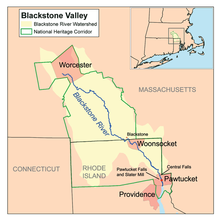Blackstone River
| Blackstone River | |
|---|---|

The Blackstone River in Blackstone, Massachusetts, just short of the Rhode Island border.
|
|
 |
|
| Country | United States |
| City | Massachusetts, Rhode Island |
| Basin features | |
| Main source | Worcester, MA |
| River mouth |
Seekonk River, at Pawtucket Falls in Pawtucket, Rhode Island 41°52′38″N 71°22′56″W / 41.8771°N 71.3822°WCoordinates: 41°52′38″N 71°22′56″W / 41.8771°N 71.3822°W |
| Basin size | 540 sq mi (1,400 km2) |
| Physical characteristics | |
| Length | 48 mi (77 km) |
The Blackstone River is a river in the U.S. states of Massachusetts and Rhode Island. It flows approximately 48 mi (80 km) and drains a watershed of approximately 540 sq. mi (1,400 km²). Its long history of industrial use has left a legacy of pollution, and was characterized by the United States Environmental Protection Agency in 1990 as "the most polluted river in the country with respect to toxic sediments."
The river is named after William Blackstone (original spelling William Blaxton) who arrived in Weymouth, Massachusetts in 1623, and became the first European settler of present-day Boston in 1625. He relocated again, to Rhode Island in 1635 and built his home on the river, in what would become Cumberland. With the Providence River, the Blackstone was the northeastern border of Dutch claims for New Netherland from Adriaen Block's charting of Narragansett Bay in 1614 through the Hartford Treaty of 1650.
The original Native American name for the river was the "Kittacuck", which meant "the great tidal river". The "Kittacuck", or Blackstone, was plentiful with salmon and lamprey in pre-colonial and colonial times.
In 1790, Samuel Slater opened the first successful water powered cotton mill in America, Slater Mill, at Pawtucket Falls. This mill was powered by the waters of the Blackstone River. Many other mills appeared along the Blackstone River over time making it an important part of American industry. The industrialization also led to the river being identified by the end of the 20th century as the primary source of Narragansett Bay pollution.
...
Wikipedia
